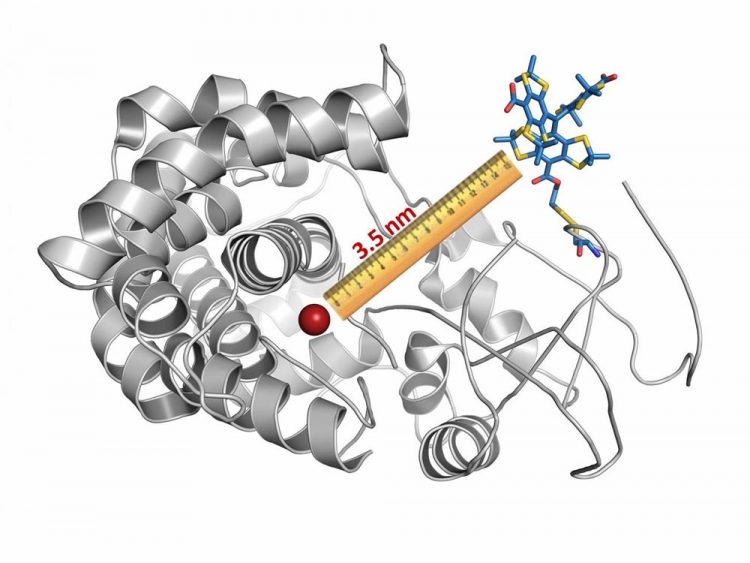Researchers watch biomolecules at work

In this case, part of the cytochrome (red) itself acted as a second label; no further marker was thus required. Using their method, the researchers were then able to ascertain the distance between both labels. Credit: © AG Schiemann/Uni Bonn
Scientists at the University of Bonn have succeeded in observing an important cell protein at work. To do this, they used a method that allows to measure structural changes within complex molecules. The further developed procedure makes it possible to elucidate such processes in the cell, i.e. in the natural environment. The researchers are also providing a tool kit, which allows a wide range of molecules to be measured. Their study has now been published in the journal “Angewandte Chemie International Edition“.
If we want to open a Christmas season walnut, we usually use a nutcracker. In the simplest case, this consists of two arms, which move against each other around a joint and can thus exert pressure on the shell. Very simple, actually – to understand how this kind of nutcracker works, it is sufficient for us to see it in action just once.
However, it is much more difficult to understand how cellular molecules work. They also alter their spatial structure as they work – similar to the nutcracker, where the arms open or close. These conformational changes tell experts a great deal about the way in which the molecule fulfills its job. Unfortunately, it is very difficult to measure these kind of movements because they occur on a very small length scale. This applies even more so if one wants to investigate the structural changes in the natural cellular environment, where countless simultaneous processes make it very hard to isolate any specific information from the general noise.
The working group from the Institute for Physical and Theoretical Chemistry at the University of Bonn has now succeeded in doing this. To this end, the scientists further developed a method that has been used for many years to measure distances within large molecules. “However, this normally only works in a test tube,” explains the head of the study, Prof. Olav Schiemann. “In contrast, our technique can also be used in cells.”
The researchers used what is known as electron paramagnetic resonance spectroscopy (EPR) for their measurements. The molecule to be measured is usually given a magnetic marker at two different sites. Through radiation with microwaves, the polarity of one of these mini magnets is reversed. The magnetic field emitted by it is thus changed, which in turn influences the second mini magnet. This influence is greater the closer both markers are to each other.
“We now measure how strongly the second magnet reacts to the reverse polarity of the first,” explains Schiemann. “From this, we can ascertain the distance between both markers.” If – metaphorically speaking – both arms of the nutcracker are marked in this way, their movement against each other can be understood.
Magnetic ruler measurements
In principle, the technique is not new. “However, we have succeeded in producing a new kind of label with which we can mark a wide range of biomolecules in a site-specific way”, explains Schiemann's staff member Jean Jacques Jassoy. Usually, these labels consist of radicals – which are chemical compounds that carry a single free electron. The electron acts as a magnet during the measurement. The problem here: single electrons are highly reactive – they try to form pairs of electrons as quickly as possible. The chemists at the University of Bonn thus used a very stable radical in their work – a so called trityl group. They created various derivatives of this trityl radical. Each of these magnetic markers is designed to target specific sites within biomolecules and thus enables several approaches for the structural analysis of different biomolecules.
In their study, the researchers used this methodological advance to investigate a protein from the cytochrome P450 group. These proteins occur in almost all living beings and fulfill important tasks, for instance during oxidation processes in the cell. “With our method, we were able to precisely measure the distance between two areas of the cytochrome to a fraction of a millionth of a millimeter,” emphasizes Schiemann´s staff member Andreas Berndhäuser.
The procedure is suitable for making biomolecule conformational changes visible in the cell. At the same time, it also generally facilitates the clarification of molecular structures. Schiemann: “We are thus providing researchers with a new tool kit that could help answer many biochemical questions.”
###
Publication: J. Jacques Jassoy, Andreas Berndhäuser, Fraser Duthie, Sebastian P. Kühn, Gregor Hagelueken, Olav Schiemann: Versatile Trityl Spin Labels for Nanometer Distance Measurements on Biomolecules in vitro and within cells; Angewandte Chemie International Edition; DOI: 10.1002/anie.201609085
Media Contact
All latest news from the category: Life Sciences and Chemistry
Articles and reports from the Life Sciences and chemistry area deal with applied and basic research into modern biology, chemistry and human medicine.
Valuable information can be found on a range of life sciences fields including bacteriology, biochemistry, bionics, bioinformatics, biophysics, biotechnology, genetics, geobotany, human biology, marine biology, microbiology, molecular biology, cellular biology, zoology, bioinorganic chemistry, microchemistry and environmental chemistry.
Newest articles

NASA: Mystery of life’s handedness deepens
The mystery of why life uses molecules with specific orientations has deepened with a NASA-funded discovery that RNA — a key molecule thought to have potentially held the instructions for…

What are the effects of historic lithium mining on water quality?
Study reveals low levels of common contaminants but high levels of other elements in waters associated with an abandoned lithium mine. Lithium ore and mining waste from a historic lithium…

Quantum-inspired design boosts efficiency of heat-to-electricity conversion
Rice engineers take unconventional route to improving thermophotovoltaic systems. Researchers at Rice University have found a new way to improve a key element of thermophotovoltaic (TPV) systems, which convert heat…



